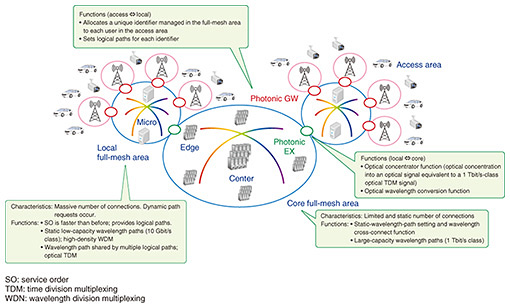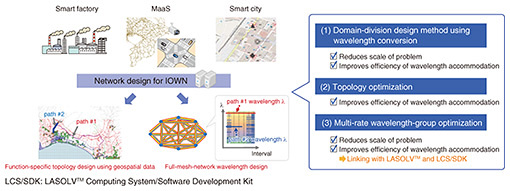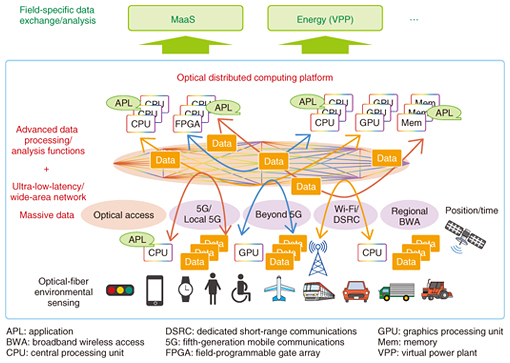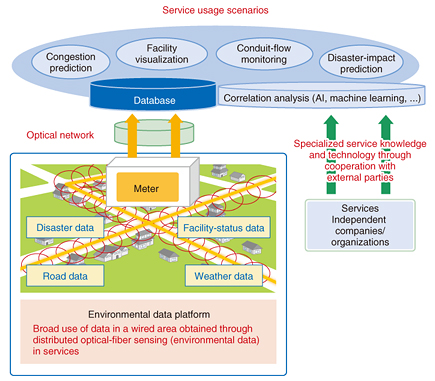03/01/2020
Innovative Network for 2030 (Beyond 2020)Arata Itoh
Senior Vice President,
Head of NTT Information Network Laboratory Group
Feature Articles: NTT R&D Forum 2019 Special Sessions, NTT Technical Review, Mar 2020.
1. Issues and solutions toward a smart world
The NTT Group aims to achieve a smart world to solve social issues in collaboration with business partners. We have begun to clarify technical issues and drawn up solutions through trials and verification experiments with a variety of partners.
Through these efforts, issues in achieving sustainable growth have come to light. The current network infrastructure is not necessarily equipped to deploy low-latency services, such as genuinely connected cars, video delivery, and remote medicine, on a nationwide scale, so there is a need to significantly increase the potential of the future network.
One direction being taken toward solving these issues is the development of a breakthrough network that can transfer inter-terminal Internet protocol (IP)/non-IP traffic without optical-to-electronical signal conversion. Based on photonics technology, Innovative Optical and Wireless Network (IOWN) will be a major key technology to solving these issues as it is a large-capacity, low-latency, flexible, and low-power-consumption network.
The following sections introduce the main initiatives in relation to the All-Photonics Network and Cognitive Foundation®, which are the fundamental elements of IOWN.
2. Main elemental technologies in the All-Photonics Network
Using the wide-band properties and flexibility of optical communication, a major feature of the All-Photonics Network is its ability to achieve an optimized function-specific network by providing a full-mesh connection of optical paths in wavelength units among many locations for each terminal, user, or service. We established the following four basic functions making up the All-Photonics Network.
- A network transport configuration function for achieving optical full-mesh networks and wireless access networks to provide high-speed and high-quality end-to-end data transfer (Function 1).
- A network design and control function for efficiently accommodating the massive number of wavelengths and frequencies needed for constructing and operating the above networks (Function 2).
- A function-specific network function for optimally combining information and communication technology (ICT) resources, such as network and computing, and meeting diverse service requirements (Function 3).
- A terminal function applying photonics-electronics convergence device technology for achieving low power consumption and low latency per unit amount of data (Function 4).
From these basic functions, we introduce elemental technologies representative of functions 1-3 (see the article "Basic Technologies toward the All-Photonics Network" in this issue for technologies of Function 4).
2.1 Optical full-mesh network-configuration technologies (for Function 1)
Two key technologies for achieving an end-to-end optical full-mesh network are petabit-class large-capacity wavelength-path technology and photonic exchange (EX)/gateway (GW) configuration technology (Fig. 1).

In terms of petabit-class large-capacity wavelength-path technology, we plan to establish ultra-high-speed optical signal transmission technologies (ultra-high-speed digital signal processing technology and ultra-high-speed optical frontend circuit technology) for achieving a maximum bit rate of 1 Tbit/s per wavelength. We will also undertake research and development of multicore/multimode technology and technology for expanding the transmission capacity per single fiber called transmission-wavelength-range expansion technology (transmission over the C- and L-bands).
To maintain scalability, we will also research and develop photonic EX, a function for directly replacing small-capacity optical paths in the domain-divided local full-mesh area with a large-capacity optical path in the core full-mesh area, and photonic GW, a function for turning back signals from the access area to the local full-mesh area directly in optical form. These functions achieve low latency and low power consumption by allocating wavelength paths dynamically instead of performing packet processing.
2.2 Accommodation-design technology based on spatial data science (for Function 2)
As described above, the All-Photonics Network allocates wavelengths for each terminal, user, or service and enables end-to-end wavelength path connections. In this regard, the explosive increase in the number of communication terminals due to the spread of the Internet of Things, mobility as a service (MaaS), etc. and the resulting combinations of communicating parties means that a massive number of optical paths will be needed. This need underscores the importance of accommodation-design technology for efficiently allocating a limited number of wavelengths (Fig. 2).

There are three key points in accommodation-design technology.
- Domain division that uses wavelength conversion technology via the photonic EX/GW functions described above. That is, the division of the local area into multiple domains and performing wavelength conversion at domain boundaries enables the reuse of the same wavelength by different domains. This makes for more efficient use of wavelength resources. Domain division also reduces the number of wavelengths that should be allocated to optical paths. The key to domain division lies in the method of division and optimization of the unit of division such as by making divisions centered about hubs having high demand for originating and terminating calls.
- Topology optimization. The idea is to derive optimal paths and topology within a domain and improve the efficiency of wavelength accommodation while enabling effective provisioning for new or additional installing of optical fibers.
- Multi-rate wavelength-group optimization. Grouping optical paths having the same route within a domain and allocating and managing wavelengths as a wavelength group make it possible to increase the efficiency of wavelength accommodation and reduce the scale of the wavelength-allocation problem. Achieving an appropriate scale for this problem enables optimal wavelength allocation using the LASOLVTM coherent Ising machine and LASOLVTM Computing System/Software Development Kit (LCS/SDK)*.
Combining these technologies makes it possible to reduce the number of wavelengths required per fiber to about 1000, which means that the system is feasible assuming the use of multicore fiber.
2.3 Optical distributed-computing-platform technology (for Function 3)
We are studying optical distributed processing technology for achieving advanced processing of large volumes of data from various devices connected to an optical full-mesh network according to diverse service requirements (Fig. 3).

The key point is the use of the large-capacity and low-latency properties of an optical full-mesh network to drive dynamic and high-density cooperative operation of computing resources distributed over a wide area. Therefore, computing resources located far from each other can be operated on as if they were located at the same location, and ever-changing resource requests can be flexibly handled. This technology can achieve both highly efficient use of computing resources and advanced data processing.
- *LCS/SDK: Middleware for solving combinatorial optimization problems with the LASOLVTM coherent Ising machine.
3. Main elemental technologies in Cognitive Foundation®
Cognitive Foundation is a mechanism for carrying out integrated deployment, configuring, and linking as well as management and operation of ICT resources on different layers such as the cloud, network services, and user facilities. In addition to making business more efficient for service providers and driving their digital transformation, Cognitive Foundation will enable even higher levels of user convenience such as the rapid provision of services to end users. Essential technologies for achieving Cognitive Foundation include user-friendly operation technology for automatically designing and autonomously operating diverse resources and technologies for enhancing and optimizing the entire system including the wired and wireless systems.
In this area, we are researching and developing natural wireless-access platform technology as an optimization technology for wireless resources. The goal is to achieve optimized wireless areas tailored to usage conditions and to link multiple wireless areas to enable the provision of seamless wireless connections regardless of the type of wireless connection. We call such wireless control technology Cradio including the quality-prediction technology for achieving optimal use of multiple types of wireless access (Fig. 4).

This technology aims to provide comfortable services for users' various demands by using artificial intelligence (AI) to predict beforehand dynamic changes in wireless communications quality accompanying the movement of drones, autonomous driving vehicles, smartphone terminals, etc. and automatically selecting and configuring an optimal wireless environment.
4. Toward the creation of new value
To enhance the value of optical fiber laid throughout Japan, we are also researching and developing the extensive use of optical fiber beyond communication fields to non-communication fields.
We can consider, for example, high-efficiency optical-energy usage technology for maintaining communications during a disaster by effectively using infinitesimal amounts of energy in optical fiber transmissions. We can also consider rolling out services by using the optical-fiber environment-monitoring technology that obtains and visualizes environmental data through optical fiber sensing as a regional environmental data platform (Fig. 5).

Our plan is to pursue research and development toward the creation of new value including non-communication fields while collaborating with a variety of partners through the IOWN Global Forum and other settings.